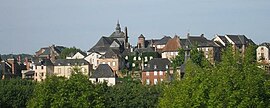|
Meyssac
Meyssac (French pronunciation: [mɛsak]; Occitan: Maiçac) is a commune in the Corrèze department in central France. Its inhabitants are called the Meyssacois(es). Toponymy The name Meyssac comes probably from the name of a Gallo-Roman landowner. Marcel Villoutreix (Les noms de lieux du Limousin, T. A. L., 2002, p. 46) gives Maniciaco in 941 from the attested name Mancius; and Mensac, Maensac around 1315. The form Maiçac corresponds to the pronunciation of the place in Occitan Limousin. Like all the communes of the historic canton of which it was the capital city, Meyssac enjoys a double display on its entrance panels. HistoryUntil 1738, the fortress of Meyssac belonged to the viscounty of Turenne. The Touchebœuf's family had long been the Lords. Fortifications and a ditch were built to protect the inhabitants from looters. Three doors allowed access: to the east, the gate de Voussée (in the direction of Beaulieu-sur-Dordogne); to the south, the Grande gate (in the direction of Martel); and finally the gate l’Auvitrie, located to the north (towards Tulle). In the eighteenth century, the ruins of these walls, having become useless and troublesome, were destroyed. As in many French towns, the wall were replaced by a large boulevard, a kind of ring road. Once you cross this border between the newer suburbs and old centre, you discover beautiful houses surrounding a church whose Romanesque steeple-porch opens onto a Gothic interior. GeographyMeyssac is located in the extreme south of the Corrèze, 20 km from Brive-la-Gaillarde. Some of its architectural treasures are gathered around its church, as well as along its alleys lined with beautiful houses of red sandstone, with the sometimes lively facades of climbing vines. The red earth, called Terre de Collonges, lends itself to pottery work.  Map of the commune. Population
EconomyThe canton retains its agricultural purpose. Most farms are of medium size (between 10 and 35 ha). The main production is of the beef Limousin cattle, and especially milk-fed-veal - a regional speciality. The wine, Mille et Une Pierres is also produced in the territory of Branceilles, the Marbot de Saillac nut, foie gras and jams, little chestnuts, goats cheese, etc. In other economic activity, tourists follow the footsteps of the pilgrims who from the tenth century, travelled to Santiago de Compostela and to Rocamadour. Turenne's rich and powerful Viscounty has made manors, castles and other noble houses flourish. Places and monumentsLe Château de Marsac
The Fairs of Meyssac, a millennial tradition
L’église Saint-Vincent et Saint-Roch
La Vieille hall
The Maison Verdès
See alsoReferences
Wikimedia Commons has media related to Meyssac. |
|||||||||||||||||||||||||||||||||||||||||||||||||||||||||||||||||||||||
Portal di Ensiklopedia Dunia




